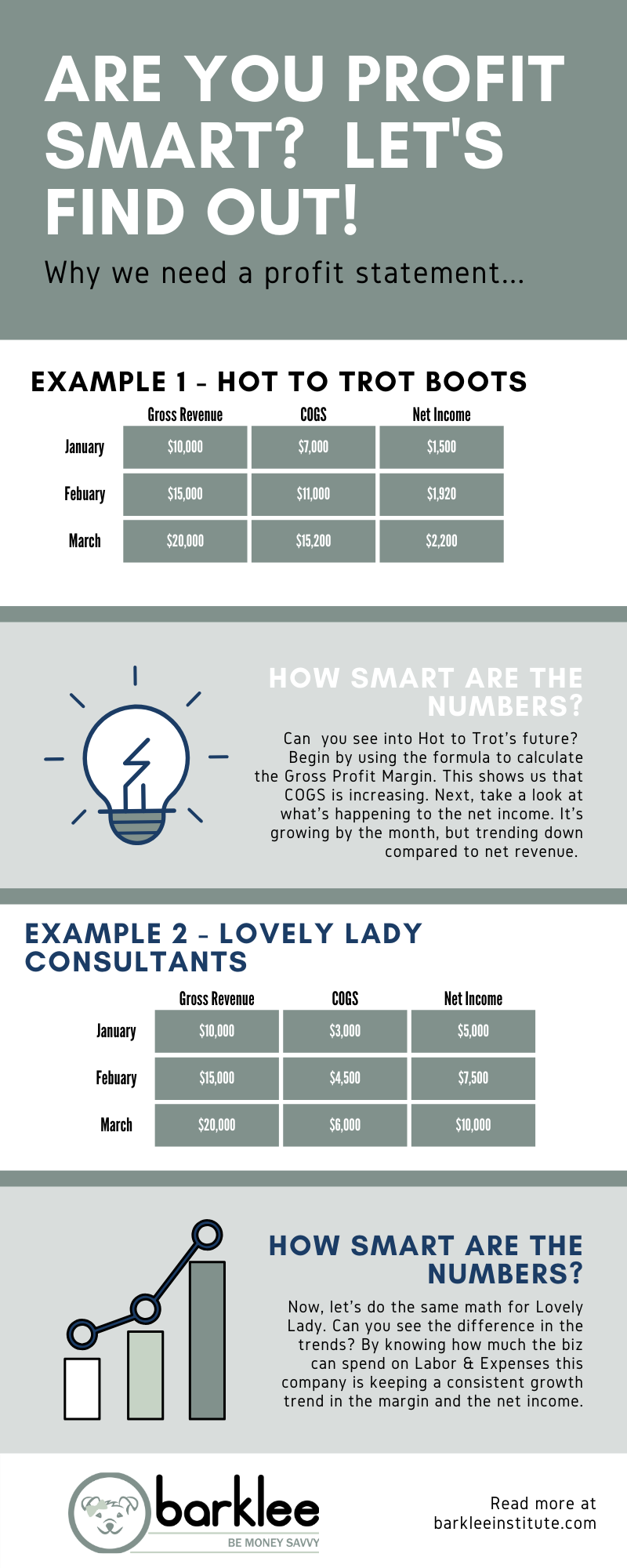Why the monthly profit statement is the difference between your small business success and failure.
The first 2 years
The first 2 years in your business are gangbusters. They will make you or break you. Every entrepreneur that has succeeded has a war story about the first 2 years of their first start-up. I can tell you that my first company did a faceplant within 6 months. I had no idea what it would take. Did you know that only 50% of start-ups will make it to 5 years, and only 33% will make it to 10 years (U.S. BLS, 2016)? What can we do to help increase our chances of small business survival?
Financial tracking, more specifically, your profit statement, is not just a math exercise, it’s the bridge between starting and succeeding. It’s no wonder that 82% of companies that fail never kept their financial records (Schmid, 2020). Your survival will hinge on your knowledge of what it costs to run your business, and how much you make at running your business. This is all summed up by creating the monthly profit statement, or financial tracking. This is your key, and I am going to show you why it makes all the difference.
This post will discuss the 5 key points around the profit statement that every mompreneur should know when taking on a small business venture; what is the profit statement, why do we need it, how to calculate your profit, the profit statement at work, and what to do next.
# 1 What is a Profit Statement?
The profit statement is a visual representation of how much money your business makes in a given period. This statement adds up your profits for the time period selected, and then subtracts the expenses incurred for that same period. The end result is the net income or the profits of the business. The profit is yours to keep, yours to put back into business growth, or yours to give away. The profit is the fruit of your labor, and the profit statement is what clearly lays out the amount of fruit you have.
#2 Why is the Profit Statement Important?
Diving deeper, the profit statement can give you major clues into why you might not be making the profit goal you were hoping for. It can show you if your upfront cost of manufacturing will eat away too much of your profit margin. These types of indicators are called Key Performance Indicators (KPI’s). You can find KPI’s for your industry, trade, or service, simply by going to your industry’s leading association website.
Here are several highlights from the profit statement:
- The gross profit margin:
- if you are a retail sales-based business then you should be tracking the cost of your inventory and applying that cost to a sale when the product gets sold. This cost is called Cost of Goods Sold, and this is an expense that is so important to your bottom dollar. Also, in states like Texas, business taxes are based on the Net Revenue for the business, so the accuracy of Cost of Goods Sold will directly affect the amount you pay in taxes.
- An expense cost as a percentage of Net Revenue:
- industry standards are all over the internet when it comes to expense ratios. Basically, you want to know if you are paying more in an expense category than the rest of your competitors. This is a great way to find margin in your budget and reduce expenses that are not necessary for your business. Simply take the amount of an expense category and divide it by the Net Revenue. This is your expense ratio, and it can be compared from period to period or across your industry, for key budget insights.
- Profitable or Not?
- What a great question. In fact, if you are not watching your profit statement monthly then you can actually be fooled into thinking your profitability is growing month to month just because your net income is growing. When the truth is you are making more money per month, but less and less money per sale.
- Is the % of net income compared to gross revenue growing or declining? Check this number by dividing net income by gross revenue or net revenue over several months. This is a KPI that will show your profitability trend for the periods selected. In fact, this is a KPI that you can be sure will be monitored if you are looking to sell your business.
#3 How to Calculate the Profit [Net Income]:
Here is the formula to the profit statement:
Gross Revenue – Cost of Goods Sold = Net Revenues
Net Revenue – Business Expenses = Net Income (THE PROFIT)
- Gross Revenue: The sum of all business income for a given period.
- Cost of goods sold: this is the cost of inventory if you sell physical products.
- Net Revenue: This can be used to calculate gross profit margin or the portion of a sale that can be used to run the business.
- Business expenses: All other business expenses incurred during the same time period
- Net Income is the Profit number we are looking for.
# 4 Real Examples to test your knowledge

- Example #1: Hot to Trot Boots, a sole proprietorship open for 6 months.
- Hot to Trot Boots is an online, boot retail company that buys gently used boots and resells them to their customers. Their initial cost to purchase the boots (COGS) is extremely variable since they have to scowl the internet in order to find people willing to part with their used boots.
- Question: Is this company growing in profitability, or is their COGS starting to eat into the profit margin?
- Example #2: Lovely Lady Fashion Consultants, LLC, open for 1 year.
- Lovely Lady Fashion Consultants is an up and coming consultation service offered via video chat for women who are ready to up their game in the wardrobe area. The company offers consultations on size recommendations, fashion trends, color, and other for their customers. They do not sell a physical product, but they hire independent contractors to consult with their customers from time to time. Remember, the cost of labor (COS) directly tied to selling the service could be considered a COGS in some or most states.
- Question: Is this company wisely paying its contractors, and are they growing in profitability?
As you have probably calculated, both companies have an increasing net income number over the 3 months, however, the second company will be the one that likely survives the first 2-5 years. Why? Unfortunately, if Hot to Trot continues the trend of an increasing COGS and business expenses, they will likely not make enough money to continue operating?
Want to test your knowledge even more? Can you predict the month that Hot to Trot will incur their first loss without additional funding or changes in their pricing structure? Leave your answer in the comments below?
# 5 Tips and Reminders for the Profit Statement:
The best advice I can give is to practice using technology in order to make your life better. We track our finances using QuickBooks Online, and I will only take on clients who are also willing to use QBO. Attempting to do the work of a profit statement by hand each month will likely increase your anxiety towards accounting. So, let the tech help you out.
Also, this is a monthly exercise and not a daily exercise. Establish a time each month where you sit down and use your software to accept your transactions, and then create your reports.
Closing
Well, you now see why tracking your finances, specifically, the profit statement can be the difference between success and failure. Remember, this is not the THE key to success, but you can be sure that the 50% who survive the first 5 years in business know their numbers. Money management must become a habit, and I believe someone once said it takes 90 days to create a habit. Good luck, friends.
Call-to-Action
Ready to learn how to use QuickBooks Online to keep track of your Profits? Go to our course page and sign up for a reminder of our upcoming course! We are putting together the most user-friendly online course for navigating QBO, and we want to help you produce your first Profit Statement. Click here to see our Courses.
References:
U.S. Bureau of Labor and Statistics. (April 28th, 2016) Business employment dynamics. https://www.bls.gov/bdm/entrepreneurship/bdm_chart3.htm. retrieved from URL.
Schmid, G. (April 15, 2020) Small business statistics: 19 essential numbers to know. https://www.fundera.com/blog/small-business-statistics. retrieved from url.

